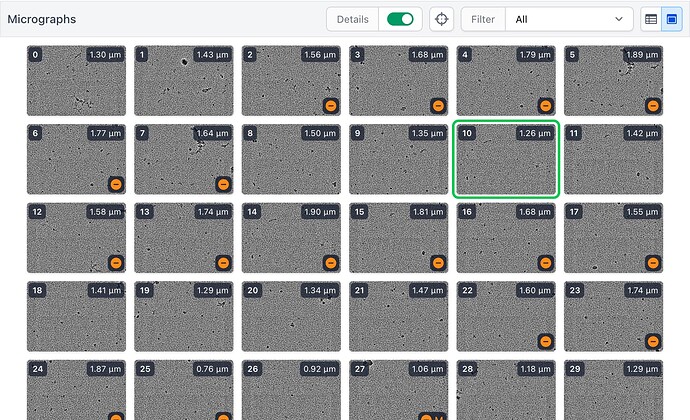Would it be possible to lower the resolution of the displayed micrographs in Manually Curate Exposures, or have a parameter that gives the option to do so? Most of the time I spend curating is often spent waiting for the micrograph to load.
curious, how long does it take? mine load 1 per second when screening individually on a MacBook. also, must you look at each? I more typically curate based on metrics such as CTF resolution, astigmatism, defocus. I presume you are not interested in single particle?
A couple of potential workarounds in a recent thread:
Hello! Here, too, images take several seconds to load (it depends greatly on the network speed, and ours is a bit old-fashioned), and I agree this is one good way to curate images. I have some images with serious graphene wrinkles and other artifacts for which I could not find a good automatic filter (trying to identify low and high outliers in ice thickness, CTFfit, astigmatism, number of picks, tilt angle… ) - very often either the filter doesn’t eliminate enough of the bad images, or it eliminates many good images. I ended up by doing something similar to the thumbnail curation as proposed in a different post, but this is pretty time consuming when we have thousands of images, one needs to script a bit to eliminate the undesired movies from the original list, then re-import the good ones (or import the bad ones and do intersect from within CS). I am not connected to a microscope, so the option of using Live to do this is not available - or at least it seems. Essentially, it would be much better to have Image Curation, or a different kind of job, displaying several thumbnails at a time for selection, just like in the Select 2D job, maybe just a bit bigger. We would be able to visually curate thousands of images in less than 1 hour. It would also help those who decide to try visual curation after their initial classifications…
I usually do reject some mrcs based on those metrics, but if the grid wasn’t great when I screened it I go through every mrc manually.
Do you need FTP access to view the thumbnails?
It depends on the network for me! When I’m working from home, my connection is decent for most purposes but still slow enough that I usually use my institute’s Citrix service so I can control an on-site remote desktop instead of having to wait for things to load on my Wifi. When I’m on-site, I’m connected to Ethernet at about 300-400 mbps, but mrc loading is still a significant portion of the time I take to curate
RE: workaround #2. The thumbnails are written to PX/JX/thumbnails/. You will need to access the folder structure independent of the webapp.
PS, thumbnails may also have been generated during motion correction, accessible from the relevant job subfolder.
Hi everyone,
Thanks for the suggestions, these are great ideas. We’re testing a redesigned exposure curation job that features an intuitive interface similar to cryoSPARC Live and performance updates to handle larger datasets more easily. In the meantime, you can start a cryoSPARC Live session and curate exposures by setting thresholds based on exposure attributes (CTF fit, relative ice thickness, etc.) or by manually rejecting exposures. More information and video tutorials are available on the cryoSPARC Live guide.
At any point you can choose to export exposures or particles from Live into the main cryoSPARC interface for additional/advanced processing.
Hi all,
Happy to report we’ve released improvements to interactive tools, notably performance upgrades and a thumbnail grid view in Exposure Curation:
This is part of v4.3 (August 9, 2023).
- Suhail
